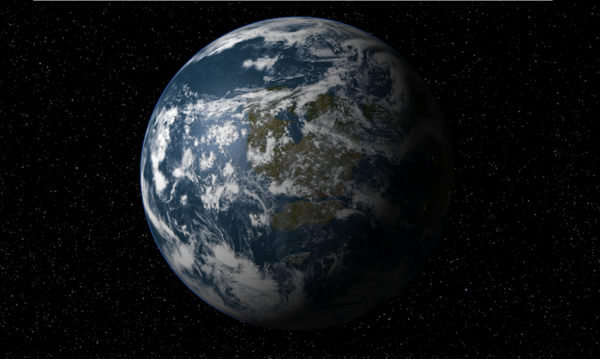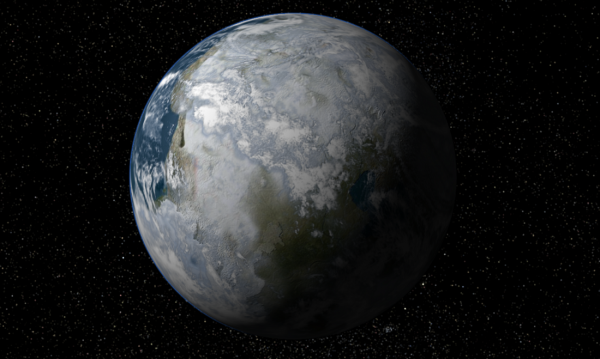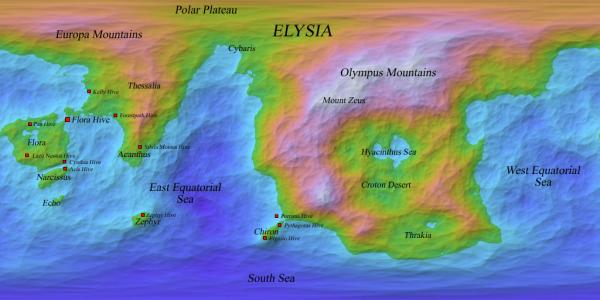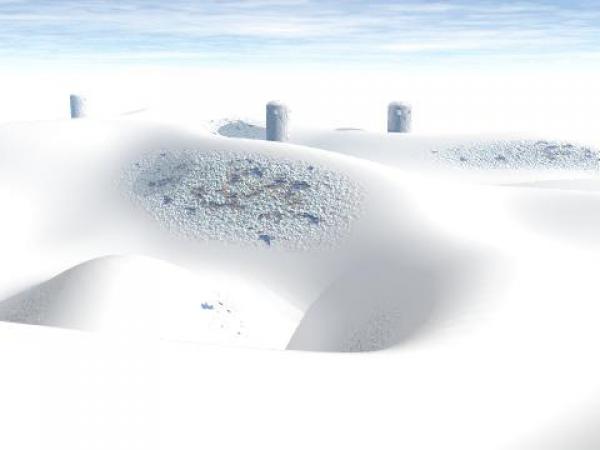BY LETTER
Arcadia (Beta Comae Berenices II)
Galactography > Regions of Space > Inner Sphere
Galactography > Systems and Worlds > Systems & Worlds A - B
Galactography > Civilized Galaxy - Sephirotic Empires > Zoeific Biopolity
Galactography > Systems and Worlds > Systems & Worlds A - B
Galactography > Civilized Galaxy - Sephirotic Empires > Zoeific Biopolity
Inner Sphere world with extreme climate fluctuations due to faulty terraforming | |
 Image from Matthew C. Johnson | |
| Winter sunset in the mountains of Arcadia | |
Arcadia- Data Panel | |
| System | Beta Comae Berenices |
|---|---|
| Location | Inner Sphere, 29 ly from Sol |
| Star | G0V |
| Luminosity | 1.375 x Sol |
| Planets | The innermost planet, Daphnis, is a semi-molten rockball. Arcadia orbits at 1.145 AU; Arcadia has one moon, Chloe, a captured asteroid 700 kilometres in diameter in an eccentric orbit. There are some orbital factories and docks there, as well as the Arcadian space biotech program specialising in hardy species adapted to vacuum and freefall. Outside Arcadia nine other planets orbit: the small worlds Dryas, Crocus, and Smilax; a pair of gas giants named Adonis and Diana, a cryojovian named Cynthia, the gas giant Pan and two ymirian worlds called Doris and Galatea. More details on these worlds here |
 Image from Steve Bowers | |
| Arcadia in the Long Summer | |
 Image from Steve Bowers | |
| Arcadia in the Long Winter | |
| Geography | Arcadia is mostly rocky with an insignificant metallic core, and is lacking in accessible metals at the surface. It has a diameter of 14170 kilometres, a density of 4.416 g/cm3, a surface gravity of 0.89 g and a mean temperature shifting between 22 degrees in the warm intervals and -5 in the cold intervals. 50% of the surface is water. The day is just 22 hours long, the axial tilt 17 degrees. Before the attempt at remote terraforming Arcadia was an Eogaian world with a thick reducing atmosphere; this was seeded in 738 AT with a range of experimental geneered photosynthetic microbes to produce an oxygen-rich atmosphere, well before the colonist ships arrived. However this technology was still in its infancy; imbalances in the carbon dioxide level led to a series of miniature ice ages recurring approximately every forty years. Although this cycle could have been adjusted later, when ecopoeisis technology became more advanced, the Arcadians chose to keep their unique climate and environment with only minor adjustments. The continent Elysia, with broad plains and occasional mountain ranges covers most of the Northern Hemisphere. Two major mountain ranges, the Olympus Mountains and the Europa Mountains encircle the Polar Plateau. In the south two major subcontinents reach out: the hospitable Thessalia and the dry and mountainous Thrakia (known for the Croton Desert with the landlocked and extremely saline Hyacintus Sea inside). The Equatorial Sea is home to several major islands, called Flora, Narcissus, Echo, Zephyr and Chiron. The southern ocean sports many archipelagos and atolls, with names picked from Greek mythology and jokes among the first colonists. The old colony was located on the shores of Elysia close to Flora, but today there exists Hives on all the main islands and Elysia as well as on the atolls. Flora is a hospitable subtropical island during the warm intervals, with a thin isthmus connecting it to Elysia. |
|---|---|
| Artificial Intelligences | AI overseers: Wallace, the venerable terraforming Hyperturing, now much altered and transcended; several other transapient beings maintain avatars on various planets in this system, notably Bridda, a Zoeific Lifegiver who has geneered diverse biospheres on the smaller worlds Dryas, Smilax and Crocus. AI's allegiance: Wallace and Bridda subscribe to the Zoeific Biopolity and its philosophy of biological development. |
 Image from Steve Bowers and John M Dollan | |
| Arcadia Before Terraforming | |
The door opened, and beyond was a dark tunnel. Damp, low, apparently dug directly into the earth — the low-tech contrast to the functional subway station behind was immense. From the ceiling roots and vague organic forms hung, sending ancestral shivers up our spines. Suddenly Michail rounded a corner, happily greeting us. Together with him were two creatures, not unlike human-sized moles with hands and wearing backpacks strapped onto their wrinkled skins. As I introduced my friends I could not help to notice the smell; pungent, animal, organic. I couldn't help it, but I always had trouble adapting at first to the Arcadian lifestyle: the multipods clinging everywhere, living clothes with symbs in them, the worker-rat manservants, the direct physical contact, the smells. But in time you got used to it, and I knew that when I returned to my home in Rembrandt it would look strangely sterile and cold.
- Jonathan Ellis-Khayama, Interstellar Diary
Before colonisation
Several mistakes were made during the colonization of Arcadia. The biotek megacorp Biotopia declared that they were ready to attempt the remote terraforming of Beta Comae Berenices II, a planet not unlike the early stages of Earth's development. Larger and less dense than Earth, it had seemingly retained a relatively thin atmosphere for nearly four billion years.Biotopia had recently developed, in secret, an experimental transapient entity known as Wallace, one of the first successful transingularity hyperturings ever constructed. To their surprise, this entity volunteered to head the mission to Beta Comae Berenices, stating that e would rather undertake such a risky mission than remain in Solsys, where the risks were much greater.
Wallace was equipped with an extensive database of current terraformation theory, a range of speculative biological templates and state-of-the-art protein-expression modelling capability. The probe was launched in 381 AT, using an early form of boostbeam. More than a hundred years later (in 518 AT) the colony ship Arkady was launched toward Beta Com, and this ship with its human cargo would take 290 years to arrive.
The probe containing Wallace and eir store of advanced biotech arrived in 683 AT, after the Great Expulsion event on Earth, which caused the end of transmissions from Solsys. Over the next 170 years, a succession of rapidly-reproducing microbial and nanotech terraforming swarms changed the atmosphere to a nitrogen/oxygen mix. Wallace attempted to introduce an Earth-like biosphere, but most species could not yet survive. Unable to receive any instructions from the home Solar System, Wallace decided to try various neogen organisms which had been designed by the Biotopia mainbrains back in Sol System before they lost contact, and other, more radical organisms designed by emself.
However the terraformation of the EoGaian world was not proceeding smoothly. Because of fluctuations and hunting oscillations in the microbe populations, the carbon dioxide levels began to swing up and down wildly. The planet underwent rapid, periodic glaciations which eventually settled into a forty year cycle, a phenomenon which continues to the present day. Although these climatic conditions had their origin in badly-applied terraformation techniques, Wallace decided to maintain them in order to support the rare and unique neogen biosphere which e had designed during this period.
During the Long Summer, which lasts twenty years, life depletes atmospheric carbon dioxide over time until the temperature falls and the planet becomes glaciated. During the twenty years of Long Winter, the actions of the hastily-designed oceanic neoplankton and fires in the neogen forests transform the accumulated biomass back into carbon dioxide, leading to an eventual thawing. Wallace attempted to redesign the biosphere to eliminate this cyclical climate change, but failed. Wallace was forced to design species that tolerated the new environment, as e could not eliminate the cyclical instability. The designs that thrived tended to hibernate or estivate for prolonged periods, or had a two-stage lifecycle adapted to the changing weather.
 Image from Anders Sandberg | |
| A Map of Arcadia | |
The Early Colonisation Period
When the Arkady arrived in 808 AT, the newly-named world of Arcadia was in its warm season. The explorers set up their base while the apologetic hyperturing briefed them on the artificial biosphere and warned them of the approaching winter. There was no way they could build subterranean climate controlled artificial gardens with enough carbon dioxide to last. It was clear that to survive the colony had to adapt. While some suggested that everybody should be frozen cryogenically to wait out the winter, it proved infeasible; this was left as a last resort. Instead 75% of the colony tried to extend the colony ship into an orbital habitat, and the other 25% began to explore the possibility of exploiting the Hives as a means of survival.The Hives were mound-like constructions, a kind of symbiotic tunnel system inhabited by several species of neogen animals and fungi. During the winters the different species of worker-rats (large, mole-like semi-sentient neogens based on giant mole rats) dug tunnels and brought back plant material to central fermentation chambers where various species of fungi grew. The fungi became food for the worker-rats and other allied species. Their excrements were gathered into other chambers where other species of fungi as well as the winter-plants exploited them: winter plants send up leaves to the surface, gathering nutrients, carbon dioxide and water in the Hive system below. In exchange for being tended the winter-plants produce fruits, which form the second main source of nutrients and distribute seeds through the Hive tunnels. As spring arrives the worker-rats produce their summer phenotype, that leaves the Hive and lives as herbivorous pack animals on the surface. The central chambers become covered with vegetation, forming small groves, and the tunnels decay. In the autumn the worker-rats begin producing the winter phenotype, which seeks out or digs Hives. They gathered all vegetation they can find, starting the cycle anew.
The Arcadians decided to dig their colony underground, linking it to several Hives in order to gather food from them. As the climate shifted, the humans moved underground, trying to adapt to a Hive existence. The first years were hard, but in time they learned the sound and chemical languages used by the inhabitants. By using their equipment they could extend the tunnels and begin to culture fungi and winter-plants more efficiently. A new form of underground agriculture took form and the Arcadians found that it was easier to control worker-rats than adapt their overground farming machinery. Still, the demands of keeping the Hives and humans supplied were high, and after many debates some genetically modified winter-plants were introduced, first to supply some rare nutrients for the humans, later for increased yields and resistance to some pests. When it was first suggested that modifying the worker-rats might be a good idea the barrier had already been broken, and in a test Hive new breeds were tested. Over the years, the colony grew with the Hives as the modified ecologies flourished.
Finally the summer arrived. Despite some misgivings the worker-rats successfully shifted, and the humans could move above ground. For the younger generation it was a new and unusual experience. The colony was retrofitted for above ground farming, treatments for agoraphobia instituted and suitable crops developed, with the assistance of the protective Wallace. The original underground tunnels were still in use. As the cold season approached, the colonists had to decide between going underground again or this time try to prepare an above ground base. The majority voted for the underground solution; a small minority remained overground to build an experimental winter base. The "topsiders" gradually dwindled as it became clear that the reasonable thing to be was beneath the ground or maybe on the orbital habitats.
The emergence of Arcadian Biotech lifestyle
Over time the Arcadians developed a society not unlike that of the worker-rats. The colony spawned a number of subcolonies linked by subways, each connected or mixed with a number of Hives. These sub-colonies, which were also called Hives, were not unlike kibbutzim: partially self-sufficient, closely knit communities. Under the tutelage of Wallace, biotechnology and ecology became dominant research areas, and modified life forms were used instead of mechanical tools in many applications. Instead of robots, modified worker-rats have been employed. Instead of non-living construction materials and furniture, the Arcadians use biologically grown species of specialised plant. From that time right up to the Current Era, Arcadian homes have increasingly become microecologies, utilising cleaning creatures, living lamps and biocomputers interfaced with the nutrient distribution systems. To outsiders Arcadians commonly appear disturbingly unconcerned about being surrounded by symbiotic creatures, including symbiotes creeping through their living clothing that eats dirt and skin flakes as well as gives comfort to their owners. Overall Arcadian culture has adapted mores suited for living underground in close proximity with other species, a tolerance for personal habits and eccentricities combined with a strong feeling of community.The Arcadian hives expanded across Elysia and the islands of the equatorial sea. The regular great colds turned out to be less limiting than expected as long as work was done underground or in space. During the warm intervals, Arcadians often spent much time and built topside, but the real cities remained safely underground.
This bioist civilisation, similar to but wholly separate from the Genetek and Genen worlds of Lalande 21185 and Frog's Head (Biotopia had long been a commercial rival of the GeneTek megacorp), later became one of the foundation stones of the Zoeific Biopolity. Over time Wallace introduced various human genetic modifications which changed the Arcadians even further. At first just adaptations and resistances were introduced, but as taboos against enhancement melted away most parents deliberately tried to get their children the best possible genome. The introduction of pheromone signals in the 1030's AT amplified the already communal tendencies, and the gradual success of aging management in the 1040's as well as the development of leader-traits transformed society even more. Much of the politics of the 1000's dealt with what modifications were reasonable and how society as a whole as well as the Hives would have a say in it. Many feared that the modifications would produce a genetic overclass, but in reality it turned out that having enhanced genes was not a super-advantage; on average the enhanced people did well, but individual skill still counted.
The First Federation Era
In 1137 a ship arrived from New America (the colony now known as Pacifica). The Arcadians greeted the fellow colonists with enthusiasm (scaring them quite a bit at the first meeting) and immediately wanted to participate in the new First Federation. Arcadia became affiliated at first to the Virginis Combine, but when that collapsed the extensively tweaked Arcadians gravitated towards Zoeticism and helped to found the new Biopolity empire, which had its capital at Ecotopia. The consensus on Arcadia was that it is better to share advantageous genetic qualities with every other colony than try to keep them secret in a futile attempt of getting ahead of others. This has made the Arcadians popular on many colonies that would otherwise find them a bit too eerie, and overall been a great publicity stunt.Society
A major factor making Arcadians different from other colonists of the Early Era is the widespread and radical human genetic modification. The first modifications were mainly for disease-resistance and enhanced senses, but over time more advanced changes have been made. Modified Arcadian humans have an advanced sense of smell and are able to understand Hive signals or track through darkness, with scent glands in the hands enabling chemical communication. Infrared vision has been achieved by adding sensory pits just beneath the nose (as in vipers) and the visual range has been extended. Many Arcadians also have enhanced hearing or even ultrasound sonar, the ability to internally secrete various drugs or medicines, hibernation or modified metabolism. Around 1020 AT some Arcadians, calling their project Yeti-Yeti, began to develop modifications to survive on the surface during the winters, gaining the ability to shift over the span of a few months between a normal human form and a "snowman" form with thick fur and other adaptations. At the same time another group, the Aquarians, began to explore developing gills and other aquatic adaptations; modern Aquarians are amphibious and can grow insulating fat and flippers as the seas get colder. Arcadian bioengineering tends towards adaptation, an attitude of being ready for everything as well as a certain delight in doing the impossible.A minority of arcadians adopt the Jumper lifestyle, freezing themselves during the Long Winter and only emerge in the warm intervals; they refer to themselves as Summerflies. Another group escaping the climate cycles are the spacers, a minority who spend most of their lives in the extensive space habitats.
 Image from Anders Sandberg | |
| The Surface of Arcadia during the Long Winter | |
Arcadians are noticeably keen on sports, from the playful exercises during the Hour of Scampering to dramatic tests of endurance, teamwork or sheer bravery. Given the availability of genetic modifications, competition sports are fairly rare or have elaborate handicap systems, while team sports (soccer and hockey are very popular) involve selecting the right combination of abilities among the participants to make a great team. One popular challenge is arachnautics: to blow through the air using a "spinchute", a dense fan of long very thin fibres that are extruded from a spinneret on the back. Originally it was used as an alternative parachute inspired by the ability of terrestrial spiders to blow long distances in the wind by extruding a silk strand, but the spinchute was soon put to recreational uses. Arachnauts either jump from air vehicles or allow themselves to be lifted by thermals; the experience is somewhere in between ballooning and parachuting and sufficiently risky to attract many of the stags.
Lifestyle
Arcadians tend towards the discreet and functional. However, clothing and lifestyle has been deeply affected by their culture. Clothing is either grown (tends to look like leather or rough fabrics) or alive. Living clothing is usual animal and furry, although during the warm intervals some Arcadians like to have plant clothes. Living clothes can repair damage, adapt to the situation, clean and comfort the owner as long as it is treated with regular nutrient baths. No Arcadian is ever found without at least some companion animals, ranging from scavenger multipods over pet lumps to augmented worker-rats that act as servants. Having good control over one's animals is a sign of style.Arcadian Hives look like a few buildings on the surface, quite often a loose collection of white ceramic towers called turres and sturdy domes. Underneath kilometres of tunnels, chambers and subways extend. During the warm seasons temporary buildings are erected over exits, while during the winter only some of the towers extend over the snow.
Some common language terms (First Federation period)
Aristos: Somebody believing himself to be above the hive or outside the social network.Augie: Augmented animal, especially one with increased intelligence. Also used as a friendly nickname for augmented humans.
Bademeister: "lifeguard", organism or implant to alert rescuers if something happens to the owner.
Cladism: The view that people should not adopt planets to suit themselves, but instead adapt to the planet. The Arcadians have rejected may proposals to normalise their environment.
Commensal: Animals or people in one's own ecosystem, sharing one's resources. Often used to denote spouses.
Cortexture: Biocomputer, usually used in adjunct with ordinary computers.
Cryp: Something hidden, surprising. Arcadian aesthetics delight in cryps: tools with unexpected extra uses, creatures with surprising abilities or just plain jokes.
Deodorante: Somebody deodorised, slightly derogatory term for offworlders.
Draz!: Common curse.
Euthenics: Genetic modifications of adults (as opposed to eugenics, improving the genes of embryos). Tricky to achieve through gene therapy, but some Arcadians have euthenic enhancements that allow them to gain new genetic modifications as adults. These enhancements unfortunately have to be put in while planning.
Expansionist: Followers of Robert McCairns' ideas about human expansion into the universe.
Franken: A "frankencreature" built from scratch by cultured muscles, neurons and tissues. Still highly experimental, but shows great industrial potential.
Gengineer: A genetic engineer. Gengineers are involved in more technical genetic engineering, genetic designers deal with the more "artistic" side (although they overlap heavily).
Goret: Small, mountain-dwelling piglike animal. Regarded as extremely delicious.
The Hour of Scampering: An afternoon lighthearted exercise for the whole hive. Originally instituted to prevent muscle weakness among the initial colonists as they holed up in the hives, today it is a tradition a bit like British tea-time in many hives to play.
Lichtmuschel: A bivalve living on walls in the Hives that has been genetically enhanced to produce light. It also eats certain pests and metasites. Lichtmuschel is also used as an epithet for a clever but asocial person, usually a gentle reminder to come and join the fun ("Don't be a lichtmuschel, go to the party!").
Lingua: Short for Interlingua, one of the creole languages of the First Federation.
Long Summer: One of the warm 20-year intervals of Arcadia.
Long Winter: One of the cold 20-year intervals.
Metasite: An undesirable species in an ecosystem, not necessarily parasitical.
Nat: A "natural", unmodified person.
Neogenists: People who favour Arcadian neogens rather than terrestrial ones; opposed by the Terrestrialists who want to introduce more Earth stock.
Neogen (or neo): A modified organism.
Tribe: A social network within a Hive (or between several) sharing the same values and goals. Tribal politics have begun to play an increasingly big role.
Perms: Either somebody wanting to live permanently underground or overground, or use an adaptation like aquarianism all the time.
Planning: The planning done by parents and genetic designers before a child is conceived.
Stags: People with leadership enhancements to their brain. Stags tend to be very charismatic, ambitious and social people, even if they also can be a bit competitive against each other.
Strasse: Street, a major tunnel.
Splice: Wedding.
Terrestrialists: People who want to introduce more terrestrial organisms into Arcadia; opposed by the Neogenists who want to base things more on Arcadian stock.
Whiff: Somebody's odour presence ("You have an angry whiff, Pjotr, should I stay away?")
Worker-rats: Genetically modified mole-rats that act as semi-sentient servants. In the Current era many have become fully sophont and gained their freedom.
Related Articles
- Arcadian Biotopics - Text by M. Alan Kazlev
Arcadian megacorp; created the weem and many other popular neogens. - Beta Comae Berenices
- GaianTundral Subtype
- Ice Age
- Xanthric Flowerweed
Appears in Topics
Development Notes
Text by Anders Sandberg, adapted by Steve Bowers
Updated by QwertyYerty 2017
Initially published on 22 September 2004.
Updated by QwertyYerty 2017
Initially published on 22 September 2004.
Additional Information
Updated 26/11/19






